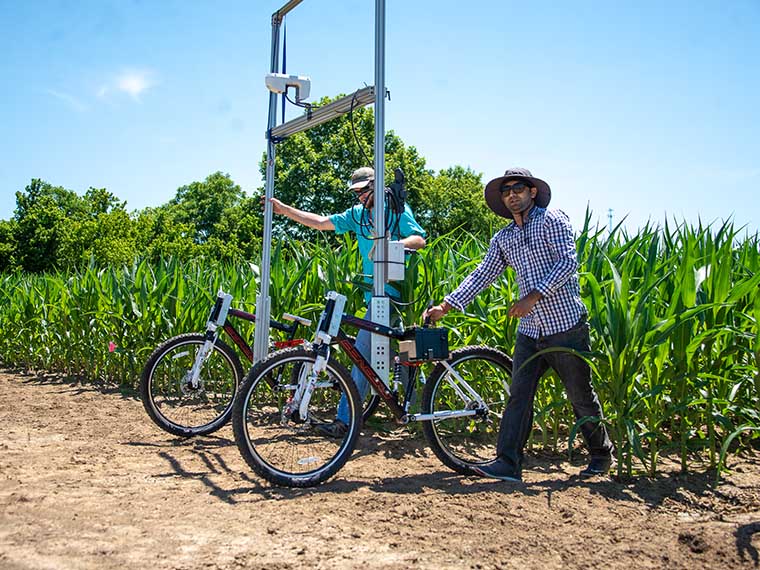W.B. Andrews Agricultural Systems Research Farm
By: Reagan Poston

Agricultural and biological engineering graduate students Rohit Pathak and Alan Thornton are collecting normalized difference vegetation index data of corn using a field sensor to compare with data acquired by a unmanned aerial vehicle at the W. B. Andrews Agricultural Systems Research Farm. (Photo by Dominique Belcher)
The information presented on this page may be dated. It may refer to situations which have changed or people who are no longer affiliated with the university. It is archived as part of Mississippi State University's history.
The MAFES W.B. Andrews Agricultural Systems Research Farm, formerly known as Ramsey Bottom, is an emblem of progress dedicated to the betterment of the agricultural community.
Acquired by the university in 1964 from Louise S. Ramsey, the 223-acre plot is located on Highway 182, diagonally across from the MAFES R. R. Foil Plant Science Research Center, commonly known as North Farm, making it a prominent locale to showcase the university's commitment to agriculture.
The family of the late Dr. Baker Andrews, an MSU alumnus and former agronomy professor, provided funding to develop the property for row-crop research.
Dr. Reuben Moore, interim vice president of MSU's Division of Agriculture, Forestry, and Veterinary Medicine shared that, of the 223 acres, 98 of them are not able to be used for row-crop research, owing to both the hilly landscape and the wide creek bisecting the property. The 125 acres of tillable soil, however, host row-crops such as cotton, corn, soybeans, and more.
"What we're ultimately trying to do through all of our row-crop research is develop the best management practices for soils from the Alabama line over to the Mississippi Delta," Moore said.
The property is used year-round. In the winter, various research on cover crops is conducted until it's time to plant row crops, when the whole property is full of life and ripe with data to be collected.
Research studies have been ongoing at the W.B. Andrews Agricultural Systems Research Farm for well over twenty years. Dr. Jac Varco, Triplett Endowed Chair in Agronomy, is involved in a study determining how potash, or potassium-based fertilizer affects crop yield. In this study, which began in 1998, potash has been applied every spring in an effort to establish a wide range of levels of potassium in the soil. Crop planting takes place shortly after application and after each subsequent harvest, crop yield is evaluated. Long-term evaluations of how potassium has impacted cotton, corn, and soybean yield have been made. In 2019, a peanut crop was added to the planting regime to determine its yield response to varying levels of potassium.
While Varco seeks to determine best management practices for fertilizer use, other researchers focus on how to protect row crops including cotton from problematic weeds and insects. For example, Dr. Te-Ming Paul Tseng is identifying naturally occurring herbicide-tolerant traits in conventional cotton, allowing scientists to breed herbicide-tolerant cotton varieties.
"Most of our studies focus on management practices producers can quickly adopt in the field, the most important of which is how to implement practices that improve crop yield," Moore said.
The value of high yield at W.B. Andrews Agricultural Systems Research Farm is two-fold. Not only does the research help producers across commodities improve crop yield, the majority of the crops are sold and the profits reinvested into the agricultural research programs.
"The research being done has a real impact as far as row-crop productivity. For instance, we've drastically increased the yield in corn on the property to more than double what it was twenty or thirty years ago. We're now looking forward to expanding the research capability of the farm, and our next step will be adding irrigation," Moore said.
The land on which the row crops grow is at a one to two percent slope, meaning that the surface water drains off easily. Next summer, construction is planned for an on-farm water storage system to utilize the run-off surface water for irrigation. This will not only keep crops steadily hydrated in the dry season but do so in a manner that is cost-efficient and allows for an increased research capacity and further progress at the W. B. Andrews Agricultural Systems Research Farm in the future.
